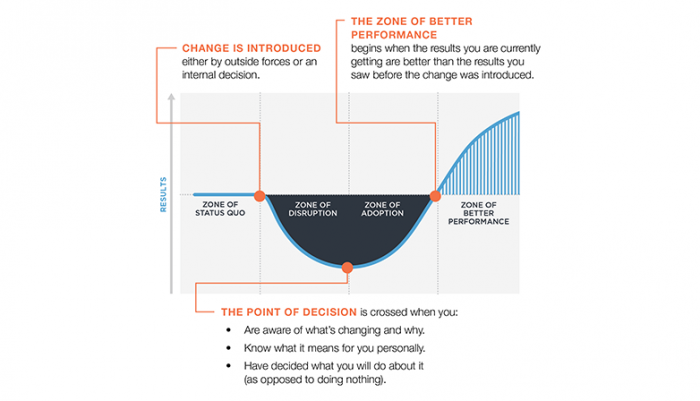Practice 5: Lead Your Team Through Change

Turn uncertainty into opportunity.
Great leaders must lead change, even when it originates from the corporate office, outside consultants, customer demands, economic turmoil, or competitors. And as a first-level leader, most of the change they face will be someone else’s idea.
Plenty of leaders can succeed during good times, but the true mettle of a leader emerges during times of uncertainty. When change comes their way (and it will), it is arguably one of the strongest tests of their leadership capability. Those leaders who show patience, stamina, emotional stability, resilience, and confidence are the most valuable to an organization and their team.
To effectively lead through change, leaders need to shift their mindset from ‘I control and contain change for my team’ to ‘I champion change with my team.’
The FranklinCovey Change Model
The outcomes of a change are often unpredictable, as are most people’s responses. The FranklinCovey Change Model is a tool to help all of us move through four common zones of adopting change.

Apply the Change Model
The Change Model applies logic and predictability to what can otherwise seem like a chaotic process. It’s a tool for diagnosing responses to ongoing change—for the team and the leader—and helping everyone navigate the roughest parts to achieve acceptance, ownership, and new levels of innovation.
Change is a sloppy process, but it can be better adopted with awareness of these four zones, especially if leaders can help make them short and shallow. Leaders can also use the model to diagnose where each team member is on the emotional curve at a given time. No two people respond to change in the same way or at the same rate. But when leaders can say, “Shawn is in Zone 3, but Megan is still stuck in Zone 2,” they can address issues on an individual basis.
Great leaders help their team members reach Zone 4 as quickly and smoothly as possible. Preparing for change in Zone 1 and managing emotions in Zones 2 and 3 will help ensure that their team’s change curve is short and shallow.
One caveat: change management is the subject of intense study and organizational-development dissertation. We’ve intentionally created a simple, clear, and actionable model that will help leaders navigate the emotional aspect of change.

People don’t resist change; they resist being changed.
The 6 Critical Practices for Leading a Team™
Leading a team requires a different mindset than working as an individual contributor. Explore the critical mindset shifts that will maximize success as a leader of others.
Increase engagement of team members by conducting regular 1-on-1s, deepen your understanding of team member issues, and help them solve problems for themselves.
Create clarity about team goals and results; delegate responsibility to team members while providing the right level of support.
Give feedback to develop team member confidence and competence; improve your own performance by seeking feedback from others.
Identify specific actions to help team members navigate and accelerate through change and achieve better performance.
Use weekly planning to focus on the most important priorities, and strengthen your ability to be an effective leader by applying the 5 Energy Drivers.



